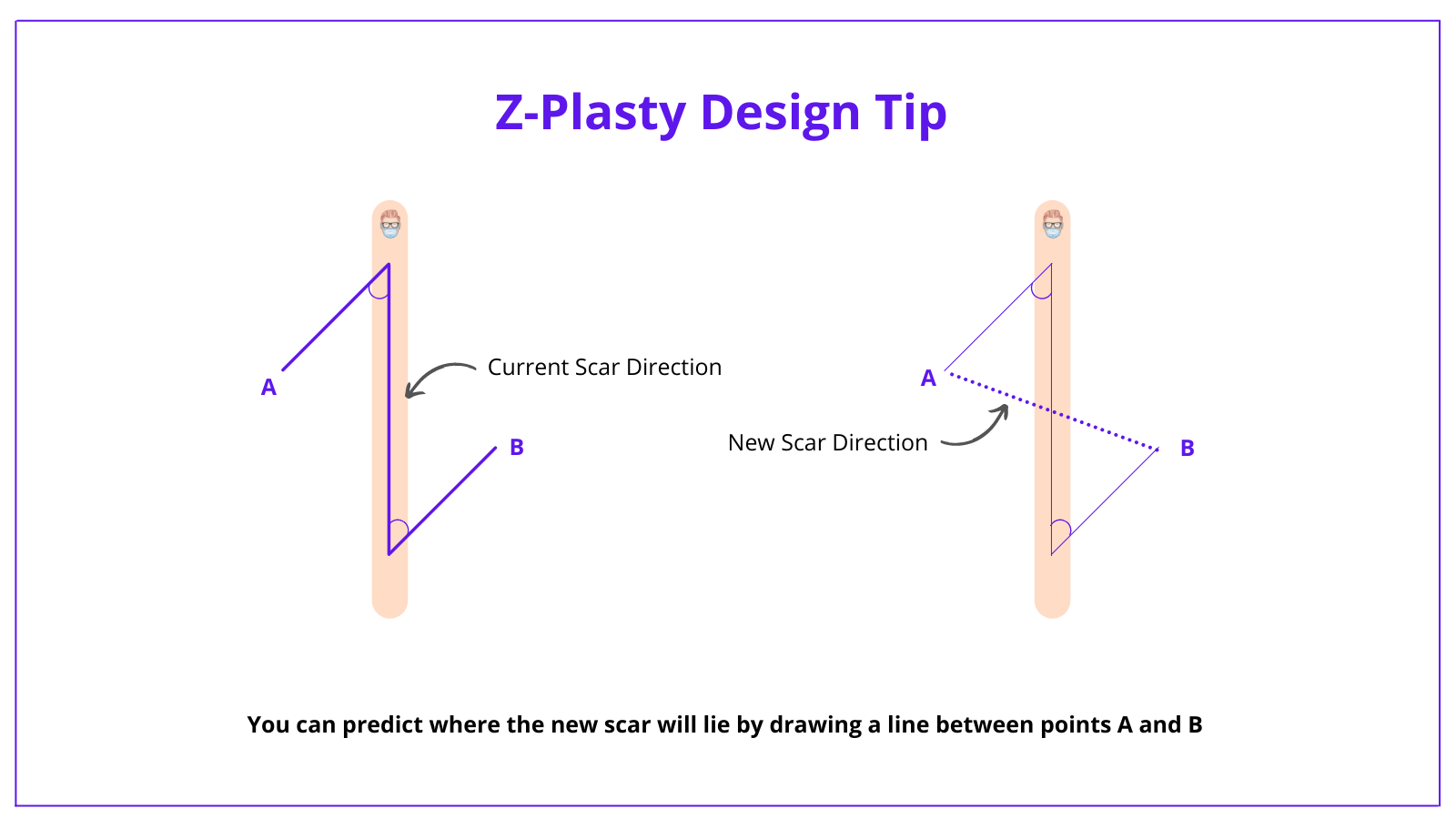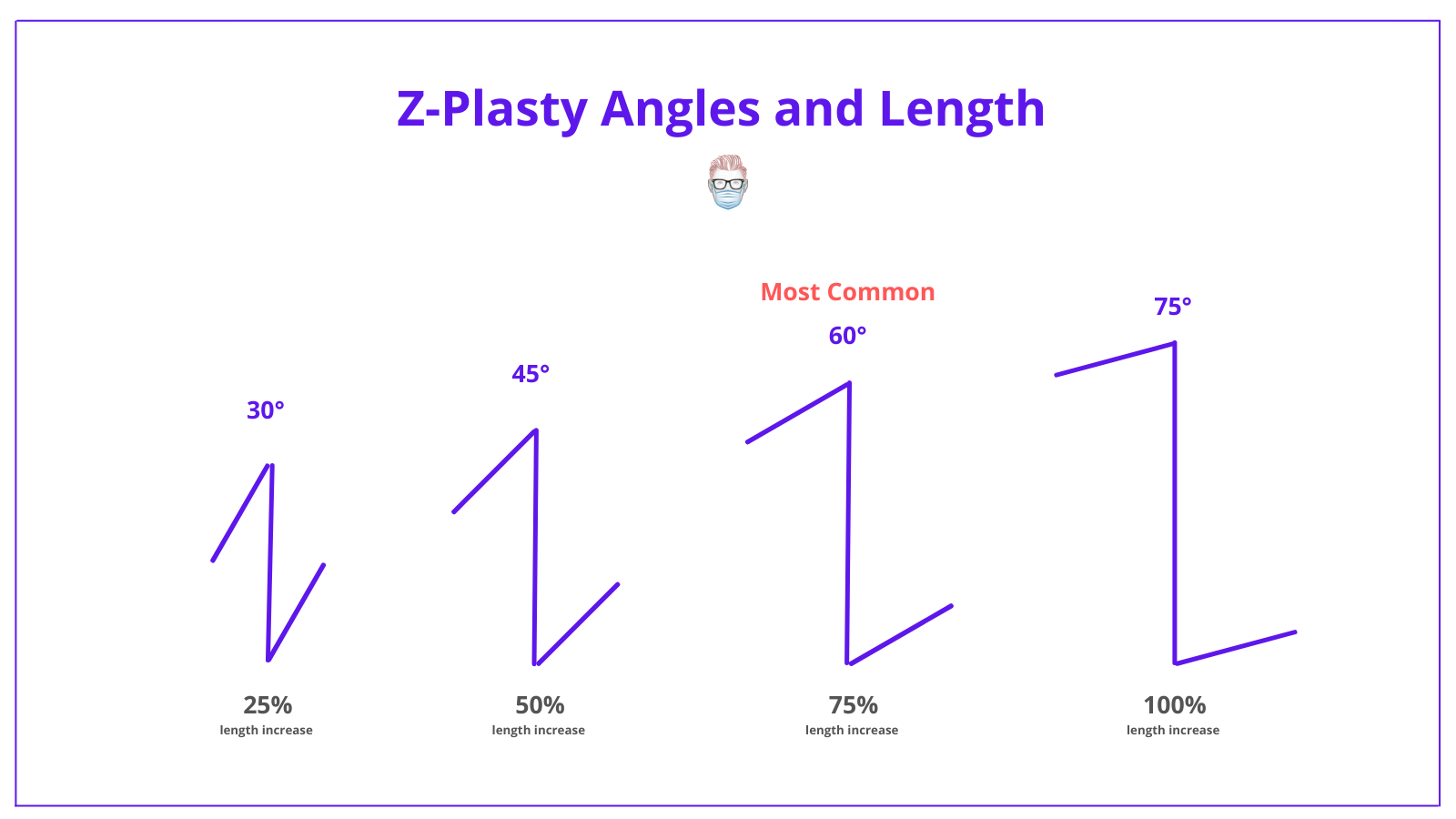In this Article
5 Key Points on Z-Plasty
2. Design is based on 3 limbs, 2 angles, and 1 scar.
3. The angle of each limb determines the length of the new scar
4. Variations include multiple z-plasties, different angles and limb lengths
5. The main complication is flap tip necrosis and delayed healing.
Definition of Z-Plasty
Z-plasty is a procedure involving the transposition of two interdigitating triangular flaps1. It is a common and widely practiced plastic and reconstructive surgery technique used for revisional scar surgery resulting in a functionally better and/or cosmetically appealing scar.
The goal of the z-plasty procedure is to:
- Lengthen a contracted scar
- Change the direction of a scar and align it with relaxed skin tension lines.
- Improve cosmesis

Indications for Z-Plasty
- Treatment of contracted scars by increasing scar length
- Improving cosmesis by changing scar direction along skin tension lines.
- Prevention of scar contracture, particularly in hand surgery.
- Facial surgery, such as McGregor flap for eyelid reconstruction
- Neck contractures from burns or webbing in Turner's Syndrome.
Z-Plasty Flap Design
3 limbs, 2 angles, 1 scar that has increased in length and changed direction.

- 3 limbs: central limb along contracture line that branches to 2 diagonal limbs.
- 2 angles: the central and diagonal limbs usually meet at 60° angle.
- 1 scar: changes direction, increases longitudinally & shortens transversely.

Whilst there is lengthening, there is transverse shortening. This means there must be transverse skin laxity for it to work.
Sometimes a scar can limit the ability to have equal angles and lengths. If this is the case then the amount of lengthening is the average expects from each angle alone.

Z-Plasty Variations
Over time, a series of Z-plasty variations have developed to treat specific areas and scar types. The two main variations are in relation to the angle, length, and the number of limbs designed.
Different Angles
A change in angle results in a change in length gained. An increase in angle does increase the length but it also increases the amount of transverse shortening.
This can be seen in the image below.

Limb length
The amount of tissue available on either side of the scar/central limb determines the amount of length. The larger the length, the larger the Z.
Multiple Limbs
The benefit of multiple-limb z-plasty is that it reduces:
- amount of transverse shortening without significantly affecting the amount of lengthening.
- tension on 1 central limb and distributes it evenly over multiple limbs.
Here is an example:
- Single Z-plasty: 2cm in longitudinal length & 2cm transverse shortening
- 4-Flap Z-Plasty (4 x 0.5cm flaps): same length, 1/4 transverse shortening.

Commonly used variations include:
- Double opposing z-plasty: limited skin availability. For example, medial canthal web or scar contracture.
- Unequal z-plasty or half-z: varied skin elasticity. For example, scar edges.
- Four flap z-plasty/limber flap: 2 extra limbs allow a considerable gain in length and are useful in severe scar contractures limiting movement example anterior or lateral neck.
- Compound z-plasty: linking several Z-plasties in series, used in the exceptionally large scar.
- Planimetric z-plasty – allows skin lengthening within the plane of skin with limb incisions twice as long as the central incision. Useful in scar interruption or skin lengthening on planar surfaces
It can be designed in "parallel" or as "skewed". Parallel design allows the flap to transposition uniformly and avoids a broad-tipped flap with a narrow base (seen in "skewed" designs).
Z-Plasty Complications
Z-Plasty combinations arise from a poor design or a poor patient selection. The main issues with this flap is:
- Flap necrosis
- Hematoma
- Wound infection
- Sloughing of Flap
- Trapdoor Effect1
Z-Plasty References & Contributions
1. Salam GA, Amin JP. The basic Z-plasty. Am Fam Physician. 2003;67(11):2329-32.
2. Aasi SZ. Z-plasty made simple. Dermatol Res Pract. 2010;2010:982623.
4. Ahmed M, Loh CYY. Double Z plasty advancement flaps for closure of large defects on the forearm. Int Wound J. 2018;15(6):1052.
5. Zito PM, Jawad BA, Mazzoni T. Z Plasty. [Updated 2020 Nov 11]. In: StatPearls [Internet]. Treasure Island (FL): StatPearls Publishing; 2020 Jan-. Available from: https://www.ncbi.nlm.nih.gov/books/NBK507775/.
6. Hove CR, Williams EF, 3rd, Rodgers BJ. Z-plasty: a concise review. Facial Plast Surg. 2001;17(4):289-94.


